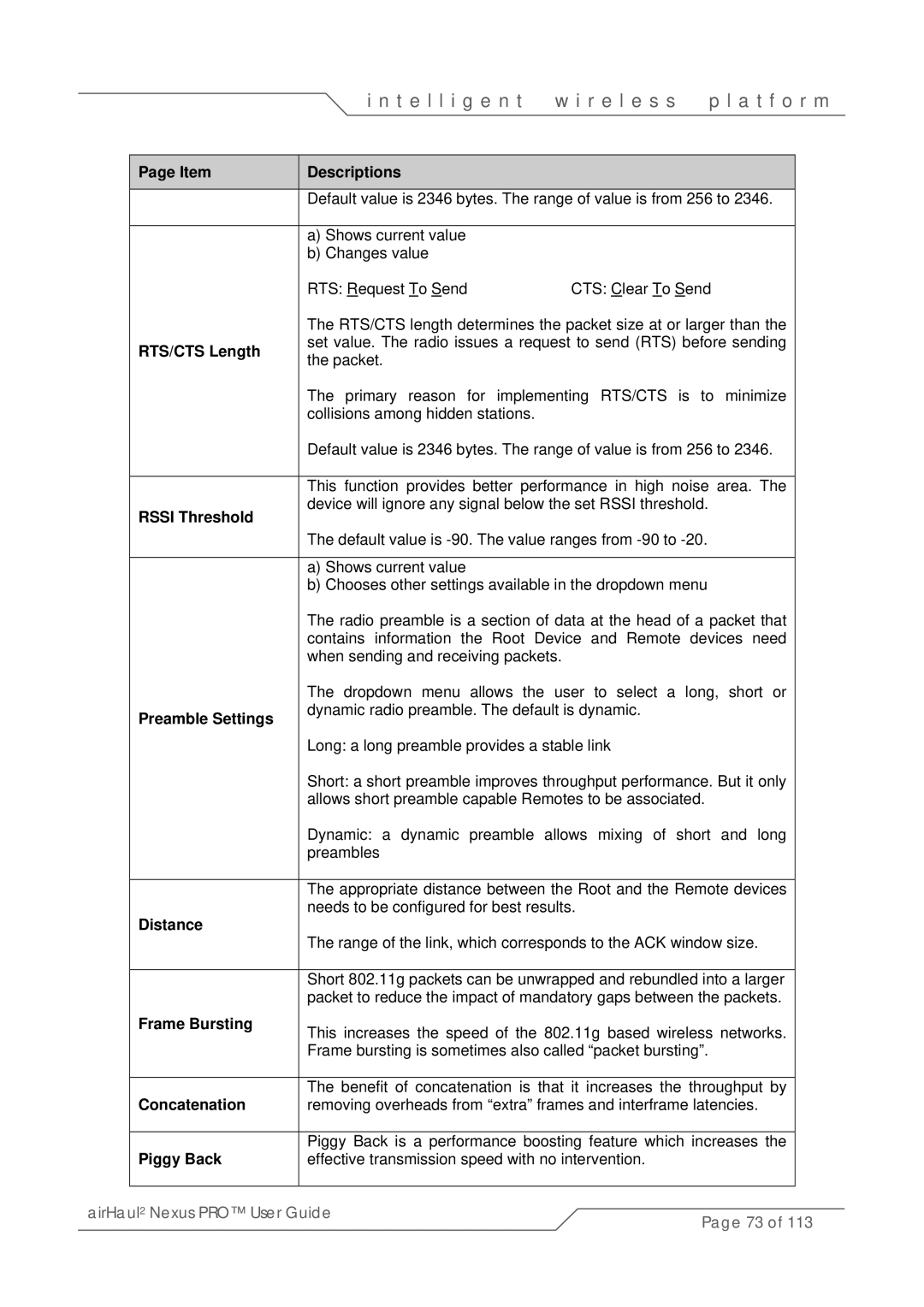
i n t e l l i g e n t | w i r e l e s s | p l a t f o r m |
| Page Item |
| Descriptions |
|
|
|
|
|
|
|
|
| Default value is 2346 bytes. The range of value is from 256 to 2346. | |
|
|
|
|
|
|
|
| a) Shows current value |
|
|
|
| b) Changes value |
|
|
|
| RTS: Request To Send | CTS: Clear To Send |
|
|
| The RTS/CTS length determines the packet size at or larger than the | |
| RTS/CTS Length |
| set value. The radio issues a request to send (RTS) before sending | |
|
| the packet. |
| |
|
|
|
| |
|
|
| The primary reason for implementing RTS/CTS is to minimize | |
|
|
| collisions among hidden stations. |
|
|
|
| Default value is 2346 bytes. The range of value is from 256 to 2346. | |
|
|
|
| |
|
|
| This function provides better performance in high noise area. The | |
| RSSI Threshold |
| device will ignore any signal below the set RSSI threshold. | |
|
|
|
| |
|
|
| The default value is | |
|
|
|
|
|
|
|
| a) Shows current value |
|
|
|
| b) Chooses other settings available in the dropdown menu | |
|
|
| The radio preamble is a section of data at the head of a packet that | |
|
|
| contains information the Root Device and Remote devices need | |
|
|
| when sending and receiving packets. |
|
|
|
| The dropdown menu allows the user to select a long, short or | |
| Preamble Settings |
| dynamic radio preamble. The default is dynamic. | |
|
|
|
| |
|
|
| Long: a long preamble provides a stable link | |
|
|
| Short: a short preamble improves throughput performance. But it only | |
|
|
| allows short preamble capable Remotes to be associated. | |
|
|
| Dynamic: a dynamic preamble allows mixing of short and long | |
|
|
| preambles |
|
|
|
|
| |
|
|
| The appropriate distance between the Root and the Remote devices | |
| Distance |
| needs to be configured for best results. | |
|
| The range of the link, which corresponds to the ACK window size. | ||
|
|
| ||
|
|
|
| |
|
|
| Short 802.11g packets can be unwrapped and rebundled into a larger | |
|
|
| packet to reduce the impact of mandatory gaps between the packets. | |
| Frame Bursting |
| This increases the speed of the 802.11g based wireless networks. | |
|
|
| ||
|
|
| Frame bursting is sometimes also called “packet bursting”. | |
|
|
|
| |
|
|
| The benefit of concatenation is that it increases the throughput by | |
| Concatenation |
| removing overheads from “extra” frames and interframe latencies. | |
|
|
|
| |
|
|
| Piggy Back is a performance boosting feature which increases the | |
| Piggy Back |
| effective transmission speed with no intervention. | |
|
|
|
|
|
airHaul2 Nexus PRO™ User Guide | Page 73 of 113 |
|
